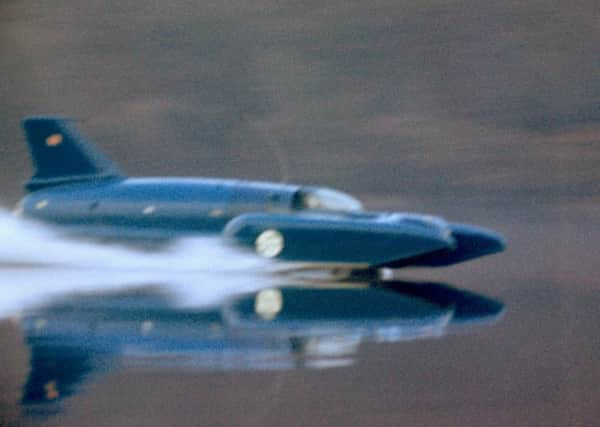Talking Motors: A restoration project with a difference


While one corner shouts to leave them be and let them rest in their original state, seldom being taken out, the other presses for mod-cons, upgraded safety and the continual ticking over of the odometer.
The right answer? Somewhere in the middle probably.
But such discussion tends to become more heated when the vehicle in question is of historical significance.
Advertisement
Hide AdAdvertisement
Hide AdA shrug of the shoulders and an: ‘It’s your car mate, do what you want,’ becomes a somewhat more passionate objection. The objector may even be incensed enough take to Twitter to cast their views.
There was a development this week in the Lake District which could reignite such feelings – though thankfully, and rightly, I haven’t seen many yet.
The brilliant people restoring Donald Campbell’s Bluebird K7 have reached a milestone by testing the boat’s new engine.
Since the wreckage of the boat was discovered in 2001, volunteers have spent the past 15 years painstakingly restoring it, in the hope of one day seeing it run on Coniston Water again.
Advertisement
Hide AdAdvertisement
Hide AdI have heard it suggested the boat should have been left where it came to rest on January 4, 1967, once it was discovered by North Shields engineer Bill Smith.
But history shouldn’t be confined to books, or grainy video images, and happily, Campbell’s daughter, Gina, has been vocal in her support of the restoration.
When Bluebird is ready to temporarily shatter the tranquillity on Coniston Water, I will want to be there, feeling my eardrums throb with the roar of the engine.
After driving to Coniston water almost 50 years ago in his Jaguar E-type, Campbell went after his own water speed record which had stood since 1964, in order to raise publicity of his rocket car venture.
Advertisement
Hide AdAdvertisement
Hide AdThis was an era when the heroic pursuit of speed captured everyone’s imaginations. On water, Campbell had held the record since 1955, breaking it himself six times. His latest attempt, as well as raising publicity, would keep the chasing Americans at bay.
Instead, he suffered a crash which cost him his life.
Since Bluebird has been recovered, the work which has gone into its restoration is a hell of a lot more impressive than your average filler and weld job under a tarpaulin.
The boat has been so difficult to build, Smith and his team have had to get almost every part specially made, and a replacement engine was donated by De Havilland Aviation in 2007 – almost identical to the original Bristol Orpheus engine.
It was successfully tested in the reconstructed chassis for the first time at Smith’s engineering yard, with Smith getting the enviable honour of sitting in the cockpit for the test.
Advertisement
Hide AdAdvertisement
Hide AdA lot of us know how a breakthrough feels on a restoration project. Imagine how this felt.
And he was rightly chuffed.
“The ghost of Donald Campbell must be looking down at me now and falling about laughing,” he said.
“We only ran it at 65 per cent power and it was just amazing. That’s about as much as we can give it in the yard, because it’ll have the building down. I absolutely loved it, not just because it’s a fun thing to do to sit in Donald’s boat and give it some beans. But because of all the work we have all put in to get to this point where it’s working.”
Easy Sunday morning? I’d rather be out in the cold
Last Sunday morning, there was a pretty big group of people suffering in the cold with useless numb fingers and mechanical failure.
Advertisement
Hide AdAdvertisement
Hide AdI was enjoying a bacon butty and what we call a ‘nice coffee’, the kind reserved for weekends, after a lie in.
But I envied people in this frozen group, as they were on the London to Brighton veteran car run.
If you’re going to line-up 400 pre-1905 cars for a 60-mile trek, it seems strange that November would be the preferred time to do it, but the run holds its place in the calendar to mark an important date to speed enthusiasts, and this year’s was a special anniversary.
To celebrate the speed limit being raised from 4mph to a hang-on-for-dear-life 14mph, otherwise known as the Locomotives on the Highway Act, a group of motorists created the first Emancipation Run 120 years ago this month.
Advertisement
Hide AdAdvertisement
Hide AdThe law which stated a man had to walk in front of a car waving a red flag was also abolished, which was as well really, as he’d have been shattered having to keep up at the new speed limit.
We’ve been left with the world’s longest-running motoring event, taking into account it restarted in 1927 after the first run, and was sidelined by the onset of the Second World War, not taking place again until 1947 because of petrol rationing.
This year also marked 130 years since German engineer Karl Benz revealed his Patent Motorwagen, a petrol-powered three-wheeler regarded as the world’s first automobile.
And one day I’d love to be at my place behind the wheel as the ceremonial tearing of the red flag sets the cars off alongside Buckingham Palace on a journey fraught with mechanical problems.
It can take up to six hours to complete and many cars don’t manage it.
So now the car wish list of the absurd and impractical has another addition.
I’m looking for anything to get me on this run.